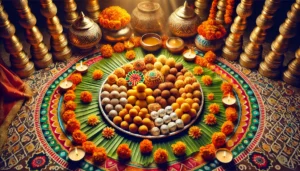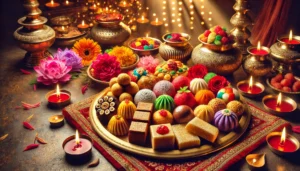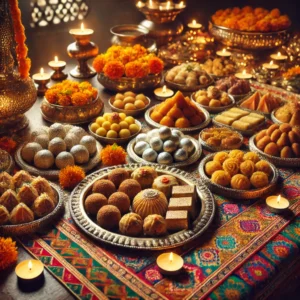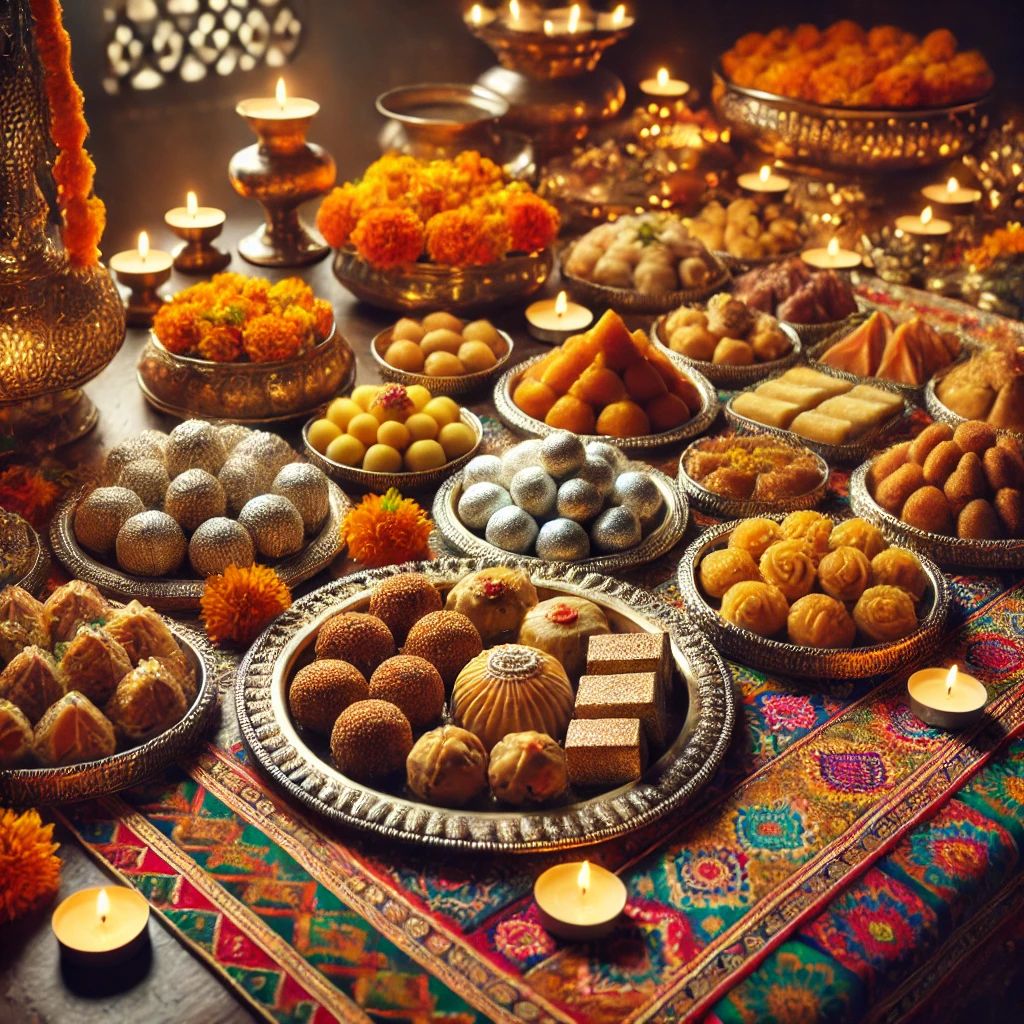
Importance of sweets in Hindu festivals
Sweet Delights: Traditional Mithais for Festivals and Rituals
India’s culinary heritage is deeply intertwined with its culture, festivals, and rituals. Among the treasures of Indian cuisine, mithais (sweets) hold a special place. These sugary delights are not just desserts; they carry with them the stories of devotion, tradition, and familial bonding. Each festival brings with it a unique array of sweets that reflect the region’s culture and the season’s bounty.
From the divine offerings of peda and modak to the joyous ladoo and luxurious barfi, mithais are integral to celebrations across India. Let us dive deeper into the traditional mithais that have graced our plates for centuries, along with their mythological significance, regional variations, and modern adaptations.
1. Peda: The Sweet of Gratitude
Pedas are one of the simplest yet most iconic sweets of India. Soft, fudgy, and delicately flavored with cardamom, they symbolize purity and devotion. These sweets are often distributed in temples as prasad (sacred offering) or handed out as a token of gratitude during celebrations.
Mythological Connection: Pedas are deeply associated with Lord Krishna, who was known for his love of dairy products. Legend has it that devotees in Mathura and Vrindavan, Krishna’s sacred lands, began offering pedas to him during Janmashtami, celebrating his playful yet divine persona. Today, Mathura’s peda is considered the gold standard, with its rich, caramelized flavor.
Regional Take: While Mathura popularized the peda, variations like Dharwad peda from Karnataka and Thirunelveli’s Palgova from Tamil Nadu bring distinct regional flavors to the table.
Recipe Tip: Adding saffron or rose water can elevate the humble peda, creating a more aromatic version for special occasions.
Table of Contents

Importance of sweets in Hindu festivals
2. Modak: Lord Ganesha’s Favorite
Shaped like a blooming flower or a closed lotus, modaks are an artistic as well as culinary delight. Traditionally made with a filling of coconut and jaggery, encased in rice flour dough, they are steamed or fried to perfection.
Mythological Connection: The modak holds a special place in Hindu mythology. According to legend, a divine modak was once offered to Lord Ganesha and his brother, Lord Kartikeya. While Kartikeya set out to circle the world to prove his devotion, Ganesha simply walked around his parents, Lord Shiva and Goddess Parvati, declaring that they were his entire universe. Pleased with his wisdom, his parents offered him the modak, proclaiming it his favorite sweet.
Cultural Significance: During Ganesh Chaturthi, it is customary to prepare 21 modaks, symbolizing prosperity and blessings.
Regional Variations: While Maharashtra is famous for ukadiche modak (steamed modaks), the fried version is equally popular in Goa and South India. In states like Tamil Nadu, sweet kozhukattai, similar to modak, is offered during Ganesh festivals.
Modern Spin: Chocolate or fruit-filled modaks have become a trendy twist, combining tradition with contemporary flavors.
3. Ladoo: The All-Rounder Sweet
Ladoos are the undisputed champions of Indian sweets. Whether it’s a festival, wedding, or even a casual get-together, ladoos are always present. Their adaptability to different ingredients and flavors makes them a universal favorite.
Mythological Connection: Ladoos have a close association with Lord Hanuman. According to legend, the monkey god adored boondi ladoos, and they are often offered in temples dedicated to him. Additionally, ladoos are considered a symbol of fertility and prosperity, making them an auspicious treat for new beginnings.
Regional Favorites:
- Besan ladoo (gram flour ladoo) is a favorite in North India, often made during Diwali.
- Rava ladoo (semolina ladoo) is popular in South India, especially during Navratri.
- Til ladoo (sesame ladoo) is a Makar Sankranti staple in Maharashtra, symbolizing warmth and togetherness during winter.
Modern Variations: Health-conscious individuals can now enjoy ladoos made from oats, quinoa, or dry fruits, offering a guilt-free indulgence.
Unlock the Ancient Wisdom of Sanatan Dharma – Join Us on YouTube!
👉 Subscribe now to Prachin Sanatan Dharma and embark on a journey of enlightenment.
Explore timeless teachings, spiritual insights, and cultural richness on our YouTube channel, Prachin Sanatan Dharma. Dive deep into the essence of Sanatan Dharma through captivating videos that inspire and educate.
4. Barfi: The Fudge of Festivals
Barfi, with its creamy, rich texture, is a star dessert during weddings, Diwali, and religious ceremonies. Whether it’s the classic milk barfi or exotic flavors like pista or kaju, this sweet never fails to impress.
Mythological Connection: Barfi may not have direct roots in mythology, but its presence in temple offerings and auspicious occasions ties it to divine blessings. The name itself, derived from the Persian word barf (snow), hints at the luxurious and pure nature of this sweet.
Regional Specialties:
- Kaju katli (cashew barfi) is a premium variety, often gifted during Diwali.
- Coconut barfi is a festive favorite in South India, especially during Onam and Navratri.
Innovative Flavors: Bakers and confectioners now experiment with chocolate, coffee, or even matcha-flavored barfis, blending tradition with modern tastes.
Why Mithais Are More Than Just Sweets
Sweets in Indian culture go beyond satisfying cravings. They are:
- Symbols of Devotion: Mithais are an integral part of temple offerings and religious rituals. They symbolize gratitude and devotion to deities.
- Connectors of Generations: The preparation of traditional sweets is often a family affair, bringing generations together in the kitchen. Recipes are passed down as cherished heirlooms.
- Markers of Celebration: From weddings to festivals like Diwali and Holi, sweets amplify the joy of every occasion.
- Bearers of Blessings: Sharing mithais during festivals spreads goodwill and strengthens community bonds.

Importance of sweets in Hindu festivals
Preserving the Legacy of Mithais
In the era of instant desserts and globalized cuisines, traditional mithais stand as a testament to India’s rich culinary heritage. However, their legacy needs nurturing. Home cooks and chefs alike are finding innovative ways to make these sweets more accessible while preserving their essence. Whether through fusion flavors, healthier versions, or creative presentations, mithais continue to evolve without losing their traditional charm.
As we savor these delightful treats during festivals and rituals, let’s remember the stories they carry, the traditions they uphold, and the joy they bring to our lives. After all, a peda is not just a peda, and a ladoo is never just a ladoo—they are sweet ambassadors of India’s timeless culture.
FAQs for “Divine Sweetness: Traditional Mithais and Their Mythological Significance in Festivals”:
- What are some iconic mithais associated with Indian festivals?
Some iconic mithais include:
Modak for Ganesh Chaturthi, symbolizing Lord Ganesha’s love for this sweet.
Ghevar during Teej, popular in Rajasthan for its intricate design and rich taste.
Kheer during Janmashtami, symbolizing devotion to Lord Krishna.
Gujiya for Holi, representing the joyous spirit of the festival.
- What makes mithais sacred in Indian culture?
Mithais are deeply tied to Indian spirituality and rituals. Made from pure ingredients like milk, ghee, and sugar, they are believed to be sattvic (pure), suitable for divine offerings. The preparation process often involves prayers, symbolizing gratitude and devotion to the gods.
- What is the significance of Modak in Ganesh Chaturthi?
According to mythology, Modak was Lord Ganesha’s favorite sweet, often symbolizing wisdom and spiritual fulfillment. It’s offered during Ganesh Chaturthi to seek his blessings for prosperity and knowledge. The process of making Modaks together also fosters unity and joy within families.
- What is the origin of Peda as a ritual offering?
Peda’s origins trace back to temples where it was prepared as prasad (a sacred offering). Its compact size, long shelf life, and rich flavor made it an ideal offering to deities and a token of blessings for devotees. Over time, it became synonymous with religious ceremonies.
- Why is Ladoo significant in Indian mythology?
Ladoo is often mentioned in mythological texts. For instance:
Tirupati Laddoo is considered sacred, offered to Lord Venkateswara in the Tirumala Temple.
Lord Hanuman is often depicted holding laddoos, symbolizing his unwavering devotion.
Ladoos are also considered auspicious in Hindu weddings and baby showers, symbolizing good luck and prosperity.
- How does each region in India celebrate mithais differently?
India’s vast cultural diversity influences its sweets. For example:
Bengal: Known for Rosogolla, Sandesh, and Mishti Doi.
Maharashtra: Famous for Modak and Puran Poli during Ganesh Chaturthi.
Rajasthan: Known for Ghevar and Mawa Kachori during Teej and Diwali.
South India: Specialties include Mysore Pak and Payasam, often offered in temples.
- How do mithais contribute to family traditions?
Preparing mithais at home is a cherished tradition passed down through generations. Festivals like Diwali and Holi bring families together in the kitchen to make sweets, fostering bonds and preserving culinary heritage.
- What modern adaptations exist for traditional mithais?
Today, many mithais are reimagined to suit modern tastes and health-conscious preferences:
Using jaggery or honey instead of refined sugar.
Incorporating superfoods like quinoa, oats, or nuts.
Fusing mithais with international desserts, such as Gulab Jamun Cheesecake or Ladoo Truffles.
- What role do mithais play in Indian festivals?
Mithais are not just food but symbols of joy, gratitude, and community. Sharing sweets strengthens social bonds, while offering them to deities during rituals represents devotion and thanksgiving.
- How are mithais connected to the concept of prasad?
Prasad is a sacred offering made to deities during worship. Mithais like Peda, Ladoo, and Kheer are commonly used because their sweetness symbolizes the blessings of the gods and the joys of life. Devotees believe that consuming prasad brings divine grace and spiritual upliftment.
- Can mithais be made at home for festivals?
Yes, most traditional mithais can be easily prepared at home. Recipes like Modak, Peda, and Ladoo require basic ingredients like milk, sugar, and ghee. Homemade sweets are considered more auspicious, as they are prepared with love and devotion.
- What is the cultural significance of distributing mithais?
Distributing mithais during festivals like Diwali, Eid, or Christmas symbolizes goodwill and joy. It strengthens relationships within families and communities while spreading happiness.
- What health benefits do traditional mithais offer?
Traditional mithais often use ingredients like nuts, jaggery, ghee, and cardamom, which are nutritious when consumed in moderation. They provide energy, improve digestion, and even enhance mood due to their rich flavors.
- How do mithais represent India’s culinary heritage?
Mithais are an integral part of India’s history and traditions, showcasing its rich culinary diversity. Recipes often carry regional and mythological influences, making them a unique blend of taste, culture, and spirituality.
Summary
“Divine Sweetness: Traditional Mithais and Their Mythological Significance in Festivals” explores the deep-rooted connection between India’s beloved sweets and the cultural, religious, and mythological traditions that surround them. Mithais like Peda, Modak, and Ladoo are not just desserts; they are carriers of stories, rituals, and spiritual meanings that transcend generations. This article delves into the history and symbolism of these traditional sweets, illustrating how they are woven into the fabric of Indian festivals and ceremonies.
Modak, famously associated with Lord Ganesha, is considered His favorite treat and plays a pivotal role during Ganesh Chaturthi. The symbolism of Modak as a sweet reward for knowledge and devotion is deeply rooted in Hindu mythology. Similarly, the simple yet divine Peda is linked to offerings in temples, often used in rituals to honor deities and mark auspicious beginnings. On the other hand, the round and wholesome Ladoo, a staple of almost every festival, carries its own charm with numerous variations and mythological anecdotes, such as its association with Lord Krishna.
The article also sheds light on how these sweets are prepared with devotion, using traditional methods and sacred ingredients that hold spiritual significance. From the use of jaggery and ghee, which are considered pure and sattvic, to the process of crafting these sweets during festive celebrations, every step reflects a blend of culinary artistry and spiritual practice.
Beyond festivals, these mithais are a central part of life’s milestones, from weddings to births, where they symbolize joy, prosperity, and gratitude. The article further uncovers how these sweets serve as a bridge between past and present, keeping ancient traditions alive in modern times.
Whether it’s the lore of Krishna playfully stealing Ladoos or Ganesha relishing Modaks, “Divine Sweetness” highlights the enduring charm of mithais as more than just confections but as integral elements of devotion, celebration, and cultural identity.
Related Articles
- Restful Nights: Ayurvedic Remedies and Traditional Indian Practices to Overcome Insomnia and Late-Night Habits
- The Tridevi: Lakshmi, Saraswati, and Parvati – Their Roles and Powers
- “Divine Creatures of Ancient Indian Scriptures: Exploring the Role of Animals in the Vedas, Puranas, and Mahabharata”
- Nature and Spirituality: Exploring the Sacred Essence of the Himalayas, Ganga, and Other Natural Wonders”
- “Reviving the Gurukul System: Relevance and Lessons for Modern Education”
- “Exploring Greek and Indian Mythology: Similarities Between Greek and Indian Mythology “
- “Embracing Sattvic Living: Harmonizing Mind, Body, and Soul Through Food and Lifestyle”
- “Charity and Prosperity: Exploring the Concept of Daan and Its Financial Relevance in Modern Life”
- How to Build an Eco-Friendly Home Inspired by Vastu Shastra
- Comparison of Ancient and Modern Sports: How Traditional Sports Have Influenced Contemporary Games
- “Timeless Lessons from Ancient Tales: Linking Samudra Manthan and Ganga’s Descent to Modern Ecological Challenges”
- “Reviving Sanskrit: How AI is Preserving Ancient Languages for the Future”
- “Mathura: The Sacred Land of Lord Krishna’s Divine Leelas”
- Investing for Future Generations: Lessons from Indian Traditions on Legacy Building and Wealth Preservation
- “Ancient Indian Wisdom: Timeless Lessons for Tackling Today’s Climate Crisis”
- “Artificial Intelligence and Spirituality: Transforming Ancient Practices for the Modern World”
- “Gold and Real Estate in India: Timeless Assets Shaping Financial Strategies”
- Tradition Meets Innovation: The Evolution of Technology in Hindu Rituals
- End-of-World Myths: Exploring Kali Yuga in Hinduism and Ragnarök in Norse Mythology
- Garuda, Pegasus, and Dragons: The Universal Ties of Mythical Beasts Across Cultures
- “Ancient Vimanas: Mythical Flying Machines or Evidence of Advanced Technology?”
- Time Travel in Hindu Mythology: The Fascinating Tales of Kakudmi and King Raivata
- “Divine Feminine Power in Hindu Mythology: The Legends of Durga, Saraswati, and Lakshmi”
- “Divine Beings of Sanatan Dharma: The Spiritual Significance of Sacred Animals in Hinduism”
- “Symbolism in Mythological Art: Unlocking Hidden Meanings in Ancient Temple Carvings”
- “Exploring Technological Advancements in Ancient India and Civilizations: Vimana, Metallurgy, & Water Management systems”
- Unveiling the Mysteries: Ancient Temples of Sanatan Dharma , Mysterious Temples of India
- “The Scientific Knowledge of Sanatan Dharma: Ancient Wisdom Meets Modern Science”
- Ancient Indian Sports and Games: Celebrating a Legacy of Skill, Strength & Strategy”
- “Exploring the Cosmic Link: The Connection Between Astronomy and Vedic Astrology”
- The Power of Sanskrit: Unlocking the Divine Language of the Gods
- “The End of Kaliyuga: A Sanatan Insight into the World’s Final Chapter”
- Explore more articles on Prachin Sanatan Yuga.
Importance of sweets in Hindu festivals Importance of sweets in Hindu festivals Importance of sweets in Hindu festivals Importance of sweets in Hindu festivals Importance of sweets in Hindu festivals Importance of sweets in Hindu festivals Importance of sweets in Hindu festivals Importance of sweets in Hindu festivals Importance of sweets in Hindu festivals Importance of sweets in Hindu festivals
Importance of sweets in Hindu festivals Importance of sweets in Hindu festivals Importance of sweets in Hindu festivals Importance of sweets in Hindu festivals Importance of sweets in Hindu festivals Importance of sweets in Hindu festivals Importance of sweets in Hindu festivals Importance of sweets in Hindu festivals Importance of sweets in Hindu festivals Importance of sweets in Hindu festivals
Importance of sweets in Hindu festivals Importance of sweets in Hindu festivals Importance of sweets in Hindu festivals Importance of sweets in Hindu festivals Importance of sweets in Hindu festivals Importance of sweets in Hindu festivals Importance of sweets in Hindu festivals Importance of sweets in Hindu festivals Importance of sweets in Hindu festivals Importance of sweets in Hindu festivals
